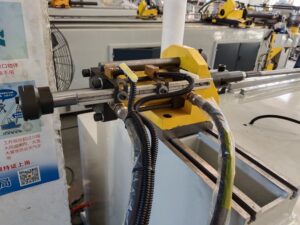How to Use a Pipe Cutter:
Mastering the Art of Pipe Cutter: From Beginner to Pro
Cutting pipes might seem daunting, but with the right tools and techniques, it’s a task anyone can master. This comprehensive guide will equip you with the knowledge and confidence to use a pipe cutter effectively.ensuring successful results every time.
Understanding Pipe Cutters: The Right Tool for the Job
Before we dive into the “how-to,” let’s explore the “why.” making them the preferred choice for many applications:
-
Clean, Precise Cuts:
Unlike hacksaws or reciprocating saws, burr-free cuts, minimizing the risk of leaks and ensuring optimal flow through the pipe.
-
Ease of Use:
Designed for effortless operation, pipe cutters require minimal force compared to other cutting tools, making them ideal for both professionals and DIYers.
-
Versatility:
Pipe cutters come in various sizes and designs, catering to a wide range of pipe materials and diameters.
-
Safety:
With their enclosed blade and controlled cutting action, pipe cutters offer a safer alternative to power tools, reducing the risk of injuries.
Choosing the Right Pipe Cutter: Size and Material Matter
The first step towards successful cutting is selecting the appropriate cutter for your specific project. Consider the following factors:
-
Pipe Material:
Different pipe materials require different cutting wheels. Ensure your cutter is compatible with the material you’re working with, be it copper, PVC, steel, or other types.
-
Pipe Diameter:
Pipe cutters are designed for specific diameter ranges. Choose a cutter that accommodates the size of your pipe for optimal cutting performance.
-
Cutter Type:
Depending on the frequency of use and desired features, you can choose from standard pipe cutters, close-quarter cutters, or heavy-duty models.
Step-by-Step Guide: Pipe Cutting Technique
Now that you’ve chosen the right tool. let’s walk through the process of using a pipe cutter effectively:
1. Preparation is Key:
- Safety First: Wear safety glasses and work gloves to protect yourself from potential hazards.
- Mark the Cut: Using a marker or pencil, clearly mark the desired cutting point on the pipe.
- Secure the Pipe: If possible, secure the pipe in a vice or pipe clamp to prevent movement during cutting.
2. Positioning the Cutter:
- Align the Cutting Wheel: Position the pipe cutter’s cutting wheel directly over the marked cutting line. Ensure the pipe sits snugly in the cutter’s rollers.
- Tighten the Knob: Turn the knob on the cutting to tighten the cutting wheel against the pipe. Don’t overtighten, as this can deform the pipe.
3. Making the Cut:
- Rotate and Tighten: Rotate the cutter around the pipe, applying even pressure. After each full rotation, tighten the knob slightly to deepen the cut.
- Avoid Excessive Force: Let the cutting wheel do the work. Excessive force can damage the cutter or the pipe.
- Complete the Cut: Continue rotating and tightening until the cut is complete. You’ll feel a slight give as the cutter breaks through the pipe wall.
4. Finishing Touches:
- Deburr the Cut: Use a deburring tool or sandpaper to remove any rough edges or burrs from the cut ends.ensuring a smooth, leak-free connection.
Beyond the Basics: Tips and Tricks for Efficient Pipe Cutting
- Lubrication is Your Friend: Apply a light coating of cutting oil to the cutting wheel to reduce friction and extend its lifespan.
- Check for Squareness: After cutting, use a square to ensure the cut is perpendicular to the pipe’s length.
- Practice Makes Perfect: Like any skill, pipe cutting improves with practice.
Troubleshooting Common Pipe Cutting Issues:
-
Uneven Cuts:
This can occur if the pipe shifts during cutting or if the cutter is not held perpendicular to the pipe. Ensure the pipe is secured and the cutter is aligned correctly.
-
Difficult Cutting:
If the cutter struggles to cut through the pipe, the cutting wheel may be dull or incompatible with the pipe material. Replace the wheel with a suitable one.
-
Damaged Pipe:
Overtightening the cutter or applying excessive force can deform the pipe. Tighten the knob gradually and let the cutter do the work.
Learn More:The invention of the pipe bending machine





